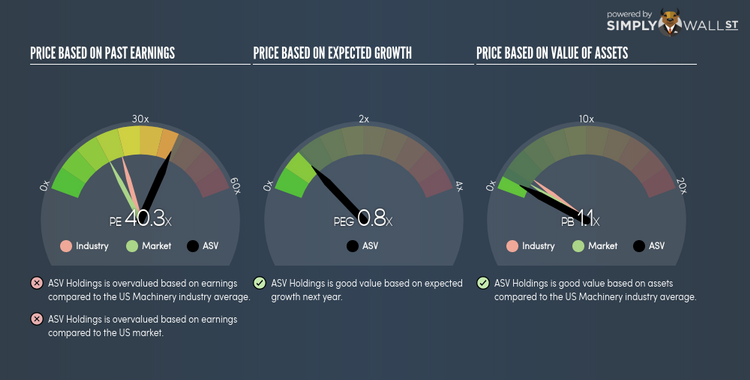Is ASV Holdings Inc (NASDAQ:ASV) A Sell At Its Current PE Ratio?

ASV Holdings Inc (NASDAQ:ASV) is currently trading at a trailing P/E of 40.3x, which is higher than the industry average of 23.1x. While ASV might seem like a stock to avoid or sell if you own it, it is important to understand the assumptions behind the P/E ratio before you make any investment decisions. In this article, I will explain what the P/E ratio is as well as what you should look out for when using it. See our latest analysis for ASV Holdings
Breaking down the Price-Earnings ratio
The P/E ratio is one of many ratios used in relative valuation. It compares a stock’s price per share to the stock’s earnings per share. A more intuitive way of understanding the P/E ratio is to think of it as how much investors are paying for each dollar of the company’s earnings.
P/E Calculation for ASV
Price-Earnings Ratio = Price per share ÷ Earnings per share
ASV Price-Earnings Ratio = $7.54 ÷ $0.187 = 40.3x
On its own, the P/E ratio doesn’t tell you much; however, it becomes extremely useful when you compare it with other similar companies. We preferably want to compare the stock’s P/E ratio to the average of companies that have similar features to ASV, such as capital structure and profitability. A common peer group is companies that exist in the same industry, which is what I use. ASV’s P/E of 40.3x is higher than its industry peers (23.1x), which implies that each dollar of ASV’s earnings is being overvalued by investors. As such, our analysis shows that ASV represents an over-priced stock.
Assumptions to be aware of
While our conclusion might prompt you to sell your ASV shares immediately, there are two important assumptions you should be aware of. Firstly, our peer group contains companies that are similar to ASV. If this isn’t the case, the difference in P/E could be due to other factors. For example, if you compared higher growth firms with ASV, then its P/E would naturally be lower since investors would reward its peers’ higher growth with a higher price. The second assumption that must hold true is that the stocks we are comparing ASV to are fairly valued by the market. If this does not hold, there is a possibility that ASV’s P/E is lower because our peer group is overvalued by the market.
What this means for you:
You may have already conducted fundamental analysis on the stock as a shareholder, so its current overvaluation could signal a potential selling opportunity to reduce your exposure to ASV. Now that you understand the ins and outs of the PE metric, you should know to bear in mind its limitations before you make an investment decision. Remember that basing your investment decision off one metric alone is certainly not sufficient. There are many things I have not taken into account in this article and the PE ratio is very one-dimensional. If you have not done so already, I highly recommend you to complete your research by taking a look at the following:
Future Outlook: What are well-informed industry analysts predicting for ASV’s future growth? Take a look at our free research report of analyst consensus for ASV’s outlook.
Financial Health: Is ASV’s operations financially sustainable? Balance sheets can be hard to analyze, which is why we’ve done it for you. Check out our financial health checks here.
Other High-Performing Stocks: Are there other stocks that provide better prospects with proven track records? Explore our free list of these great stocks here.
To help readers see pass the short term volatility of the financial market, we aim to bring you a long-term focused research analysis purely driven by fundamental data. Note that our analysis does not factor in the latest price sensitive company announcements.
The author is an independent contributor and at the time of publication had no position in the stocks mentioned.

